.webp)
Chief Executive Officer

An IT security audit is more than just a checkbox for compliance—it’s a critical step in protecting your business from cyber threats. Whether you're handling sensitive customer data or managing internal systems, knowing where your security gaps are can save you from costly breaches. In this blog, you’ll learn what an IT security audit involves, how to conduct one effectively, and what best practices to follow. We’ll also explore the different types of audits, common mistakes to avoid, and how to prepare your team for the audit process.
[.c-button-wrap2][.c-button-main3][.c-button-icon-content2]Contact Us[.c-button-icon-content2][.c-button-main3][.c-button-wrap2]
An IT security audit is a comprehensive review of your organization’s information systems, policies, and controls. Its goal is to identify weaknesses that could lead to security incidents or data breaches. These audits help you understand your current security posture and ensure that your systems meet industry standards and regulatory requirements.
Audits typically assess areas like access controls, network security, and data protection. They also evaluate how well your security policies are being followed. A well-executed audit helps you find potential security issues before they become real problems. It also supports compliance with regulations like HIPAA, PCI-DSS, or local data privacy laws.

A successful audit doesn’t happen by accident. It requires planning, the right tools, and clear communication. Here are the key steps to follow:
Start by identifying what systems, departments, or processes will be audited. This helps focus your efforts and ensures nothing critical is overlooked. Include all relevant stakeholders in this planning phase.
Before testing anything, review your current security policies. Are they up to date? Do they align with current threats and technologies? This sets the baseline for your audit.
Check who has access to what. Are permissions based on job roles? Are there inactive accounts still enabled? Weak access controls are a common source of security gaps.
Use tools to scan for vulnerabilities in your network, servers, and applications. This may include running a penetration test to simulate a real-world attack.
Look at how sensitive information is stored, transmitted, and backed up. Make sure encryption is used where needed and that backups are secure and tested regularly.
Record what was tested, what issues were found, and what actions are recommended. Clear documentation helps with follow-up and future audits.
Once the audit is complete, prioritize the issues and assign tasks to address them. Set deadlines and track progress to ensure improvements are made.
Regular audits offer more than just compliance—they strengthen your entire security program.

There are several types of audits, each serving a different purpose. Internal audits are done by your own team to check ongoing compliance. External audits are performed by third-party security auditors to validate your systems against industry standards.
A compliance audit focuses on meeting specific regulations, while a technical audit dives deep into your infrastructure and systems. Some audits are scheduled, while others are surprise checks to test real-world readiness. Choosing the right type of audit depends on your goals and industry requirements.
Security auditors use a variety of techniques to assess your systems. These methods help uncover hidden risks and validate your controls.
Automated tools scan your systems for known weaknesses. This is a fast way to identify outdated software, misconfigurations, and missing patches.
Also known as ethical hacking, this technique simulates an attack to see how well your defenses hold up. It’s useful for testing real-world scenarios.
Reviewing system logs helps auditors detect unusual activity, failed login attempts, or unauthorized access. It’s a key part of identifying potential security incidents.
Auditors check system settings to ensure they follow best practices. This includes firewall rules, password policies, and encryption settings.
Talking with team members helps verify that policies are understood and followed. Walkthroughs of processes can reveal gaps that tools might miss.
Auditors examine your written policies and procedures to ensure they are complete, current, and aligned with your actual practices.
Some audits include testing how employees respond to phishing emails or fake support calls. This checks the human side of your security.

Preparation is key to a smooth and effective audit. Start by gathering all relevant documentation, including security policies, network diagrams, and access control lists. Make sure your team knows the audit is coming and what their roles will be.
Assign a point of contact to work with the auditor and answer questions. Review past audit findings and confirm that those issues have been resolved. Finally, test your systems ahead of time to catch any obvious problems before the audit begins.
Follow these best practices to improve audit outcomes and reduce stress during the process.
A consistent audit process builds long-term security and trust.

Are you a business with over 10 employees looking to strengthen your security? Growing companies often face new risks as they expand. An IT security audit helps you stay ahead of threats and meet compliance requirements.
At AJTC, we specialize in IT security services and managed IT security services tailored to your needs. Our team can guide you through the audit process, identify risks, and implement solutions that protect your business. Contact us today to get started.
[.c-button-wrap2][.c-button-main3][.c-button-icon-content2]Contact Us[.c-button-icon-content2][.c-button-main3][.c-button-wrap2]
An audit is a comprehensive review of your systems, while a compliance audit focuses on meeting specific legal or regulatory standards. Both are important. A general audit helps identify security gaps and improve your security posture, while a compliance audit ensures you're meeting required security standards.
Regular security audits should be done at least once a year. However, if your business handles sensitive information or has recently changed systems, more frequent audits may be needed. Regular audits help detect potential security issues early and maintain strong security controls.
An internal auditor can conduct basic checks, but for a more thorough review, a certified security auditor is recommended. They bring expertise in information security and understand the latest threats. Involving a third-party also adds objectivity to the audit process.
Your checklist should cover access controls, network security, data protection, and policy reviews. Don’t forget to include penetration test results and audit findings. A strong checklist ensures no critical areas are missed during the audit.
There are several types of IT security audits, including technical, compliance, and operational audits. Each type of audit serves a different purpose. For example, a compliance audit ensures regulatory alignment, while a technical audit focuses on system vulnerabilities.
To ensure an effective IT security audit, prepare in advance, involve key stakeholders, and follow best practices. Use managed IT security services to support your efforts. An audit helps uncover hidden risks and improve your overall security practices.